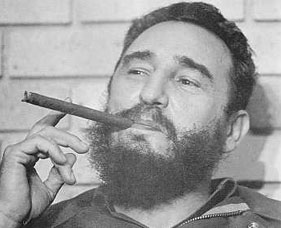 Fidel Castro. The names rings familiar
throughout the world. One of the most influential and powerful
leaders in Latin America. A name that everyone knows. For some when
they hear Castro, they think revolutionary, president, liberator.
Others think dictator, communist, bully. How can one man have so many
labels associated with one name. It must come from being the ruler of
a country for over forty years. When you take a look back, one can
see why he would have the label of liberator and dictator. How one
man went from being a revolutionary who wanted nothing but freedom
and equality, to a communist dictator who was being puppet-ed by the
soviet union.
Fidel Castro. The names rings familiar
throughout the world. One of the most influential and powerful
leaders in Latin America. A name that everyone knows. For some when
they hear Castro, they think revolutionary, president, liberator.
Others think dictator, communist, bully. How can one man have so many
labels associated with one name. It must come from being the ruler of
a country for over forty years. When you take a look back, one can
see why he would have the label of liberator and dictator. How one
man went from being a revolutionary who wanted nothing but freedom
and equality, to a communist dictator who was being puppet-ed by the
soviet union.
Born to a sugar plantation owner,
Castro grew up wealthy in the poverty stricken country of Cuba. He
attended private Jesuit institutions and eventually law school at the
University of Havana. Here he became passionate about socialism,
anti-imperialism, and nationalism in Cuba. In a place where the
wealthy ruled and the poor suffered, Castro wanted equality. He was
wealthy, handsome and charismatic. Trust was given to him easily. His
care for others led people to believe that he could be the answer to
Cuba's oppressed government. His determination was shown when he
traveled to the Dominican Republic to attempt to overthrow dictator
Rafael Trujillo. Even though the mission was unsuccessful it only
fueled his fire for liberty and reform.
When Fulgencio Batista took over the
Cuban government in 1952, Castro knew something had to be done. His
first attempt to overthrow Batista in 1953 was a failure and he was
captured and jailed. He was released from jail in 1955 and went to
Mexico. Here he met fellow revolutionary Che Guevara and here they
began to devise a plan to overthrow Batista for good. In 1956, Castro
and Guevara led a group of 81 revolutionaries attacked using
guerrilla warfare. Over the next two years they waged war on
Batista's government. Finally in 1959 Batista's government fell and
Castro was now in control.
For a long time, the people of Cuba
praised Castro and his ideas. He wanted nothing to do with America
and pledged to be completely uninvolved with the United States. He
implemented a total embargo on the United States. Nothing came from
them and nothing was given to them. He also put restrictions on Cuban
citizens leaving. His strong rule started to transition from a
presidency to a dictatorship. He soon refused to let anyone leave
Cuba. After some time, the people of Cuba became worried that Castro
was a puppet of the Soviet Union and that he was strongly communist.
Because of his embargo on the United States, Castro became dependent
on trade with the Soviet Union. The relationship between the two
nations was so close that when the Soviet Union fell in 1991, Cuba
entered a time of extreme economic hardship. Somewhat similar to when
Castro led his invasion to liberate the country.
The country suffered such oppression
that Castro's own daughter, Alina Fernandez, who did not agree with
her fathers political ideas, had to flee the country. was not an
easy feat for her as she was not allowed out. She had to disguise
herself with heavy makeup, a wig and even weight gain to escape Cuba
as the “Spanish tourist” in the passport she had obtained. Her
goal in escaping was to giver herself and her daughter a better life,
and to shed light on the government run by her father. Her book
describes how her father went from being a revolutionary hero to a
dictator that ruled a country under communist ideas for over 40
years.
Sources.
http://www.biography.com/people/fidel-castro-9241487
http://www.globalresearch.ca/cuba-under-fidel-castro/3084
Fernandez, Alina. Castro's Daughter. An Exiles Memoir of Cuba. 1998. Print
No comments:
Post a Comment